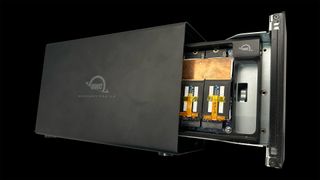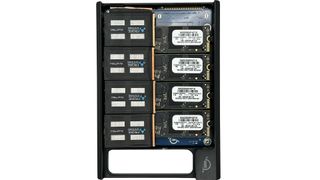Frore System Unveils World's First 64TB SSD 3.5-inch Storage Enclosure With Solid-State Cooling
Solid State Drives Meet Solid State Cooling

Frore Systems, the inventors behind the world's first solid-state cooling devices, has unveiled a new 64TB U.2 SSD storage device cooled by the company's AirJet Mini. Made in collaboration with OWC, the storage enclosure is known as the Mercury Pro and is the first storage enclosure to utilize Frore System's technology.
For more details on Frore System's solid-state cooling technology, check our previous coverage. The quick summary is that Frore System's AirJet Mini and AirJet Pro coolers are the world's first solid-state cooling devices featuring no moving parts. With a thickness of 2.8mm and a heat dissipation of 5W for the Mini and 10W for the Pro, respectively, the cooling capacity per mm is much higher than traditional cooling methods. Both devices can actively cool incredibly slim or compact devices that previously could only be cooled via passive cooling, or with weak active cooling solutions.
OWC's new Mercury Pro is the first external storage enclosure to use an AirJet cooler. In the past, Frore Systems advertised its AirJet Mini and Pro as CPU/SoC coolers specifically, but in this case, the AirJets have been adapted to cool storage devices instead, thanks in no small part to the AirJet Mini's ultra-thin form factor.

The unit houses eight M.2 SSDs in a compact 3.5-inch U.2 enclosure, with four SSDs residing on the top while the other four are installed on the bottom of the case. Each SSD gets its own AirJet Mini, attached to the SSD with a copper heat exchanger and thermal pads. OWC's variant comes with eight 8TB SSDs, yielding 64TB of capacity as a whole, with throughput of 2200MB/s and 2600MB/s for sustained sequential writes with the added cooling capacity.
Thanks to the AirJet's cooling capabilities, the Mercury Pro is able to dissipate 40W of heat, in a form factor the size of a single SATA hard drive. If this same amount of cooling potential used conventional fans, the storage enclosure would have to be significantly thicker to accommodate the extra hardware.
Sadly, OWC and Frore Systems have not announce a potential release date for the enclosure, and it goes without saying that it targets enterprise customers. We suspect both companies need to do more testing to ensure the AirJet-equipped enclosure is reliable enough for extended run times. Frore System's new AirJets appear capable, but the design methodology is still very new and mostly unproven in the real world. That will change, once more OEMs start using AirJet coolers in their systems — like Zotac's AirJet-powered ZBox.
Stay On the Cutting Edge: Get the Tom's Hardware Newsletter
Get Tom's Hardware's best news and in-depth reviews, straight to your inbox.

Aaron Klotz is a freelance writer for Tom’s Hardware US, covering news topics related to computer hardware such as CPUs, and graphics cards.
-
thestryker I'm happy to see this tech popping up more and really hope we'll see some direct to consumer cooling products using it. STH had a bit about M.2 cooling they'd seen at the Flash Memory Conference: https://www.servethehome.com/a-new-take-on-passively-cooled-pcie-gen5-nvme-ssds-phison-frore/Reply -
gg83 I love it! No more of those stupid 8inch tower coolers for m.2 ssd's! Just slap some rgb on these beauties and I'll be happy. I wonder if the tech can in theory handle the insane power from gpu or cpus.Reply -
thestryker Reply
These are the current model specs:gg83 said:I love it! No more of those stupid 8inch tower coolers for m.2 ssd's! Just slap some rgb on these beauties and I'll be happy. I wonder if the tech can in theory handle the insane power from gpu or cpus.
AirJet Mini removes 5.25 Watts of heat at a silent 21 dBA noise level, while only consuming a maximum of 1 Watt of power.
AirJet Pro removes 10.5 Watts of heat at a silent 24 dBA noise level, while only consuming a maximum of 1.75 Watts of power.
They're definitely good enough to do lower power laptop chips already (they use multiple hooked up to a single heatpipe/heatsink), and Zotac has shown a mini pc design using one. They're a long way away from being able to cool anything desktop class, but it will be interesting to see how far the tech will scale.
Most Popular


